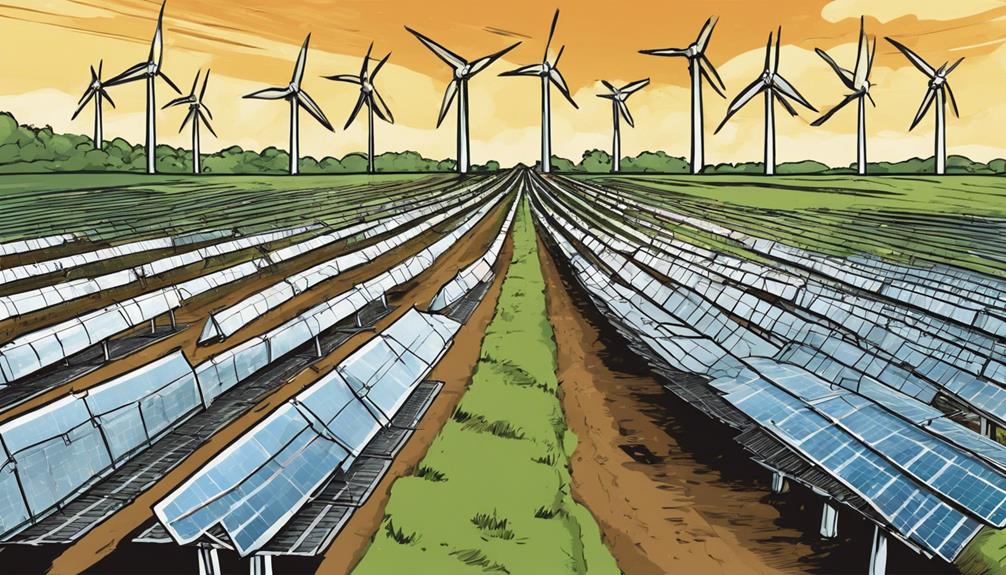Geothermal energy is extracted by drilling underground for hot water or steam, while solar energy converts sunlight into electricity through photovoltaic panels. Geothermal tends to be smaller scale and excels at direct power generation, ideal for heating and cooling, with over 90% capacity. Solar power, more common on rooftops, generates utility-scale electricity with 20-30% capacity. Geothermal offers continuous output, while solar's generation relies on sunlight availability. If you want to understand more about the differences between these two sustainable energy sources, there are more details waiting for you in further sections.
Key Takeaways
- Geothermal energy relies on heat from Earth's core, while solar energy harnesses sunlight.
- Geothermal is constant and reliable with high capacity factors, whereas solar energy output varies.
- Geothermal excels in baseload power, while solar energy is suitable for peak demand.
- Geothermal energy is smaller scale for direct power, whereas solar is commonly used for utility-scale generation.
- Geothermal has higher upfront costs but lower operational expenses compared to solar energy.
Solar Energy Mechanisms
Solar energy mechanisms involve the use of photovoltaic (PV) panels that convert light from the sun into electricity efficiently. These solar PV panels are made of materials like silicon and are arranged in arrays to generate power ranging from watts to megawatts, depending on the size of the installation.
The global average capacity factor for solar energy typically falls between 20-30%, affected by factors such as weather conditions and the orientation of the panels.
Solar energy is a versatile source of renewable energy suitable for various applications, from small-scale rooftop installations to large utility-scale solar farms. By harnessing the abundant energy from the sun, solar power has the potential to reduce carbon footprints significantly and lower electricity bills for both residential and commercial consumers.
Embracing solar energy not only benefits the environment but also offers a sustainable and cost-effective solution for meeting energy needs.
Geothermal Energy Mechanisms

Geothermal energy mechanisms involve extracting heat from the Earth's core through various systems. These mechanisms differ from solar energy conversion processes, showcasing the unique way geothermal energy taps into the Earth's natural heat reservoirs.
Understanding these mechanisms can shed light on the distinct advantages of geothermal energy over solar energy in certain contexts.
Geothermal Energy Extraction
Utilizing underground drilling techniques, the extraction of geothermal energy involves accessing hot water or steam reservoirs within the Earth's crust.
Geothermal systems employ closed-loop systems that circulate a working fluid through underground piping loops to capture geothermal heat efficiently. Alternatively, open-loop systems extract hot subsurface water or steam to the surface for energy generation.
Geothermal heat pumps take advantage of the Earth's stable underground temperatures for heating and cooling purposes, providing a sustainable and cost-effective solution for climate control.
These extraction processes boast high efficiency rates, consistently generating over 90% of their rated capacity.
Solar Energy Conversion
Harnessing the power of the sun through photovoltaic panels converts solar energy into usable electricity for various applications. When it comes to solar energy conversion, photovoltaic energy plays an essential role in generating power efficiently.
Here are some key points to keep in mind:
- Solar power is harnessed through photovoltaic panels that convert sunlight into electricity.
- Photovoltaic energy directly transforms solar energy into usable electrical power.
- Energy production from solar panels relies on the photovoltaic effect to convert sunlight into electricity.
- Heat transfer mechanisms aren't directly involved in solar power generation but aid in various applications.
- Solar energy conversion is a sustainable and renewable way to produce electricity for homes, businesses, and more.
Application and Scale Differences

When considering the application and scale differences between geothermal and solar energy, it's essential to understand the distinct ways in which these renewable energy sources are utilized.
Geothermal energy is often implemented on a smaller scale, primarily for residential heating and cooling systems. Geothermal systems excel in direct power generation under specific geological conditions, while solar arrays on rooftops provide distributed power, allowing individuals to offset grid purchases and enjoy the benefits of solar energy.
In contrast, solar energy is commonly deployed on a larger scale for utility-level electricity generation, harnessing the significant solar capacity available. For residential heating and cooling applications, geothermal heat pumps stand out as an efficient and environmentally friendly choice.
Understanding these differences in application and scale helps in determining the most suitable renewable energy source for various needs and locations.
Capacity Factors and Generation

What distinguishes the capacity factors and generation characteristics of geothermal energy from solar energy?
Geothermal energy typically boasts a high capacity factor, maintaining over 90% of its rated capacity consistently. In contrast, solar energy, especially solar PV, averages capacity factors around 20-30% globally due to variations in sunlight availability and geographic location.
Geothermal's high capacity factor guarantees reliable and continuous power generation, making it ideal for baseload renewable energy generation. On the other hand, solar energy generation is more dependent on external factors, leading to fluctuations in output.
Here is a breakdown of the key differences:
- Geothermal energy maintains over 90% of its rated capacity consistently.
- Solar energy, specifically solar PV, averages capacity factors around 20-30% globally.
- Geothermal's high capacity factor guarantees reliable and continuous power generation.
- Solar energy generation varies based on sunlight availability and geographic location.
- Geothermal energy's consistent output makes it ideal for baseload renewable energy generation.
Global Resource Potential Comparison

Geothermal energy's global resource potential exceeds 200 GW worldwide, surpassing the varying solar resources dependent on climate and latitude. Geothermal energy stands out with its reliability and high capacity factors, consistently performing above 90%.
In contrast, solar energy's capacity factors typically range from 20% to 30%, influenced by factors like sunlight availability and weather conditions. While both geothermal and solar energy offer substantial resource potential, geothermal's consistent output and high capacity factors make it an attractive option for continuous power generation.
Solar energy, on the other hand, relies on the availability of sunlight, making it more variable in its generation profile. Understanding the differences in global resource potential and capacity factors between geothermal and solar energy is essential for determining the most suitable renewable energy sources for specific locations and energy needs.
Capital and Operating Costs Analysis

Considering the evolving landscape of renewable energy technologies, how do the capital and operating costs of geothermal and solar energy systems compare in relation to long-term financial viability?
Geothermal energy often incurs higher capital costs due to specialized drilling equipment and underground loop systems. Conversely, solar energy has seen decreasing installation costs, enhancing its long-term cost-effectiveness.
Geothermal energy may have higher initial drilling costs, while solar energy might have slightly higher operating expenses compared to geothermal systems. However, geothermal energy offers consistent output with minimal operating expenses once the system is in place, potentially balancing the higher upfront investment.
Here is a breakdown to help you understand better:
- Geothermal energy: Higher capital costs due to specialized equipment.
- Solar energy: Decreasing installation costs improving long-term viability.
- Geothermal energy: Higher initial drilling costs.
- Solar energy: Slightly higher operating expenses.
- Geothermal energy: Consistent output with minimal operating expenses post-installation.
Environmental Impact Evaluation

When evaluating the environmental impact of renewable energy sources like geothermal and solar energy, it's important to take into account their sustainability and carbon footprint reduction benefits.
Geothermal energy stands out for its minimal environmental impact as it operates without emitting greenhouse gases. This characteristic makes geothermal energy a sustainable option for reducing carbon emissions.
On the other hand, solar energy harnesses the sun's power to generate electricity, effectively lowering the carbon footprint associated with traditional fossil fuel-based electricity generation. Solar panels can also be recycled, further enhancing their eco-friendly profile over their lifecycle.
Both geothermal and solar energy offer environmentally friendly alternatives that contribute to a cleaner energy future.
Geothermal energy's continuous and reliable operation adds to its sustainability credentials, while solar energy's ability to reduce carbon emissions makes it a compelling choice for environmentally conscious energy consumers.
Reliability and Suitability Comparison

Geothermal energy boasts exceptional dependability, ensuring consistent power output for baseload energy needs.
Solar energy's reliability hinges on sunlight availability and weather conditions, necessitating proactive measures for stability.
Evaluating the dependability and suitability of both energy sources is vital for optimizing performance and grid integration.
Reliability Comparison
With over 90% availability and consistent power generation, geothermal energy stands out as a highly reliable option for baseload renewable energy. Geothermal's continuous heat source guarantees stable power output, making it a dependable source for long-term energy needs.
In contrast, solar energy's reliability hinges on sunlight availability and weather conditions, necessitating advanced forecasting and grid integration for stable power generation.
- Geothermal excels in providing stability services for grid balancing due to its predictable maintenance and continuous heat source.
- Solar energy is ideal for scalable dispatchable peak capacity.
- Geothermal energy is best suited for 24/7 baseload renewable generation.
- Geothermal's high reliability and consistent output make it a dependable source for long-term energy needs.
- Solar energy complements geothermal by offering scalable dispatchable peak capacity, balancing out geothermal's intermittent generation profile.
Suitability Assessment
For evaluating the suitability of geothermal and solar energy, consider their reliability and suitability for different energy generation needs. Geothermal energy stands out for its over 90% availability, providing consistent power generation that makes it highly dependable for baseload renewable energy requirements. It offers dependable power output, making it ideal for continuous heating and cooling needs. Geothermal heat pumps also excel in providing stability services for grid balancing, making them appropriate for 24/7 baseload renewable energy generation.
On the other hand, solar energy, although intermittent and reliant on sunlight, is well-suited for scalable dispatchable peak capacity in regions abundant with sunlight. Solar energy requires advanced forecasting and grid integration measures to guarantee dependable power generation and grid stability.
While geothermal energy provides predictable maintenance schedules and consistent power output, solar energy's suitability lies in its ability to complement geothermal energy by offering peak capacity during times of high demand.
Performance Evaluation
When comparing the reliability and suitability of geothermal and solar energy, their performance characteristics reveal distinct advantages for different energy generation needs.
Geothermal power offers over 90% availability with consistent performance, making it reliable for baseload renewable energy generation. On the other hand, solar energy requires advanced forecasting and grid integration due to its reliance on sunlight availability, making it suitable for scalable peak capacity generation.
Geothermal excels in providing stability services for grid balancing, ensuring reliable power supply with predictable maintenance schedules. Solar energy is ideal for offsetting peak electricity demand and can be combined with energy storage solutions for enhanced reliability during fluctuations in sunlight.
Geothermal is recognized for its 24/7 baseload renewable energy generation capabilities, while solar energy is best suited for dispatchable power generation to meet varying demand levels.
Energy VS, Power Your Home effectively with the right choice based on your specific energy requirements.
Energy Sources Overview Comparison

Comparing geothermal energy and solar energy as energy sources reveals distinctive benefits and applications for residential and commercial use.
Geothermal energy is primarily utilized for heating and cooling, making it an excellent choice to save money on heating expenses. By harnessing heat from the Earth's core, geothermal power plants or heat pumps provide efficient heating solutions.
On the other hand, solar energy is a versatile power source, capable of generating electricity to power appliances and reduce electricity bills. While solar energy relies on sunlight availability, geothermal energy taps into the Earth's consistent heat production.
Geothermal energy is ideal for properties where digging depth is limited and offers significant cost savings in heating and cooling applications.
Solar energy can complement geothermal systems in regions with limited sunlight, providing a renewable energy alternative with lower initial investment costs compared to geothermal options.
Frequently Asked Questions
What Is the Difference Between Geothermal Energy and Solar Energy That Warms Earth's Surface?
To understand the difference between geothermal and solar energy warming Earth's surface, consider their distinct sources. Geothermal energy taps into the Earth's core heat, providing continuous warmth. Solar energy relies on sunlight, varying with daylight and weather conditions.
Is Solar More Expensive Than Geothermal?
When deciding between solar and geothermal, consider your budget. Solar panel installations generally cost less upfront compared to geothermal systems. So, if cost is your main concern, solar might be the more affordable choice for you.
What Is the Difference Between Solar Energy and Solar Thermal Energy?
When differentiating between solar energy and solar thermal energy, remember that while solar energy encompasses all uses of sunlight, solar thermal energy specifically focuses on using sunlight to generate heat, such as for water heating.
Why Is Geothermal Energy More Reliable Than Solar?
When it comes to reliability, geothermal energy outshines solar. Geothermal's steady output of over 90% rated capacity guarantees constant power generation. Solar's reliance on sunlight makes its power output fluctuate, lacking the consistency of geothermal.
What are the advantages and disadvantages of using biofuel compared to geothermal and solar energy?
When comparing biofuel use vs renewable energy like geothermal and solar, biofuels offer the advantage of being a readily available and easily adaptable source of energy. However, the disadvantages include concerns about land use, food competition, and emissions. Geothermal and solar energy, on the other hand, have minimal environmental impact and are more sustainable in the long run.
Conclusion
In the grand dance of renewable energy, geothermal and solar bustle on the same stage, each with their unique moves.
Geothermal sways deep below the surface, tapping into the earth's warmth like a hidden treasure.
Solar, on the other hand, dazzles from above, harnessing the sun's rays with elegant grace.
Together, they showcase the diverse beauty and potential of sustainable power sources, inviting us to join in their harmonious performance towards a brighter future.










